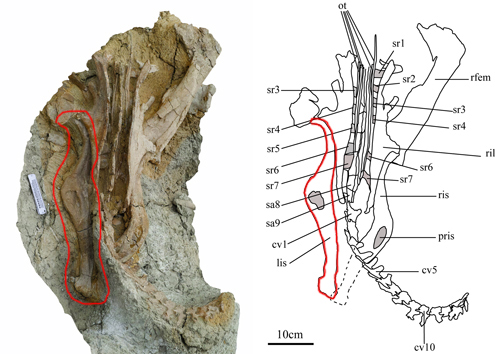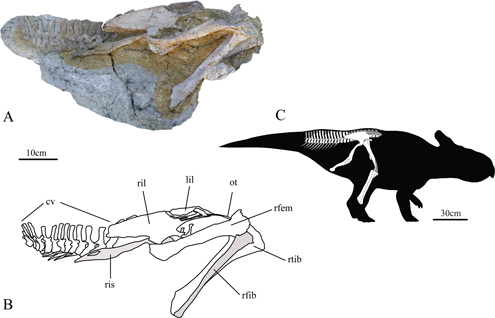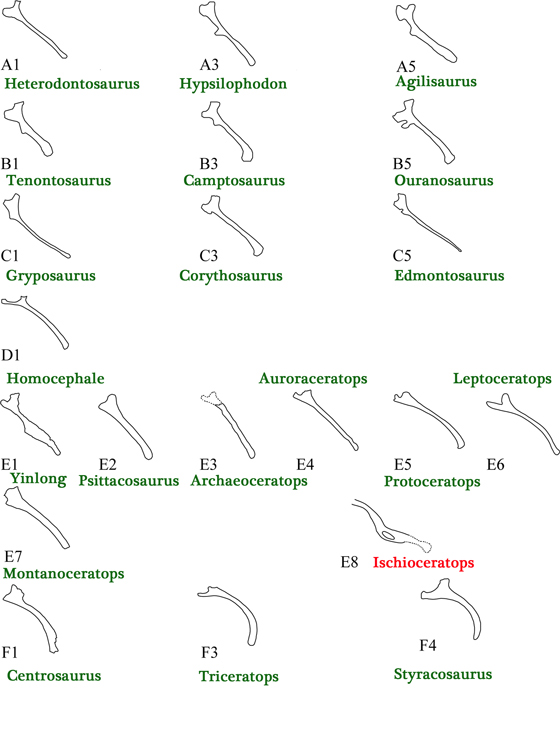Another Potential Leptoceratopsid from China
Ischioceratops zhuchengensis – Potentially a New Leptoceratopsid
A team of international scientists including researchers from the Institute of Vertebrate Palaeontology and Palaeoanthropology (Beijing), the Chicago Field Museum and the Zhucheng Dinosaur Museum, (Zhucheng, Shandong Province, China) have published a paper on the fossilised bones of a Late Cretaceous leptoceratopsid, one that although scientifically named may turn out to be further material that ends up assigned to Zhuchengceratops.
Ischioceratops zhuchengensis
This new dinosaur has been named Ischioceratops zhuchengensis but as the fossils were found at about the same stratigraphic level as the holotype material assigned to Zhuchengceratops, Ischioceratops may end up as a junior synonym of Zhuchengceratops inexpectus. Let’s explain.
A New Leptoceratopsid
The Holotype Material of Ischioceratops zhuchengensis
Picture credit: PLOS One
The picture above shows the fossil material used to describe and name this new genus of the family Leptoceratopsidae. The fossils found include the right femur (thigh bone), plus the lower leg bones from the right hind limb (tibia and fibula), along with the anterior portion of the tail (articulated tail bones), a complete sacrum, both halves of the pelvis and a number of ossified tendons.
Although a only a portion of the skeleton representing a single individual has been found, and it is from the animals backside, not to put too fine a point on it, the morphology of the bones, especially those bow shaped ischia have enabled scientists to firstly, confidently assign these fossils to the Leptoceratopsidae family and secondly to erect a new genus for this Chinese dinosaur.
A Dorsal (Top Down) View of the Fossil Material

A top down view of the fossil material with the left ischium ringed in the photograph and highlighted in the line drawing.
Picture credit: PLOS One
The picture above shows the unique shape of the ischia (a pair of bones that make up part of the pelvic girdle. The bone is curved sharply towards the proximial end of the bone (part of the bone closest to the animal’s trunk). In the photograph above the left ischium in the photograph has been ringed and in the line drawing opposite the same bone has been highlighted.
Although there has been some distortion and displacement as part of the fossilisation process the research team are confident that is the shape of the actual bone and therefore they have erected a new genus.
Assigning a Leptoceratopsid to a New Genus
Naturally, with such a unique autapomorphy (distinctive anatomical feature) associated with the ischia, it is only appropriate to name this new dinosaur after this feature. Hence the name Ischioceratops zhuchengensis (this means ischium horn-face from Zhucheng), the trivial name honours the fossil find location, the city of Zhucheng, in the south-east of Shandong Province.
Assigning the Fossils to a New Genus based on the Ischia
Ossified tendons indicate a member of the Ornithischia and the shape of the actual bones suggests that this animal was an example of a leptoceratopsid. Those never-seen-before ischia have resulted in the erection of a new genus. No other dinosaur known* has a pelvic bone quite shaped like these two, therefore the research team felt confident that a new dinosaur could be added to the fold.
Left Side Views of Other Ornithischian Dinosaurs Compared to Ischioceratops
Picture credit: PLOS One with modification and additional annotation by Everything Dinosaur
The picture above shows a number of line drawings of the left ischium of a number of well-known ornithischian (bird-hipped), dinosaurs. Although more closely related to the ceratopsians listed (E to F) than to the other bird-hipped dinosaurs included in the diagram, the unique shape of the ischium of Ischioceratops can clearly be seen. It is on this basis, that the dinosaur fossils, currently part of the collection of the Zhucheng Dinosaur Museum have led to the establishment of a new dinosaur genus.
The fossil material has been dated to the Late Cretaceous (72 million years ago to 66 million years ago approximately – Maastrichtian faunal stage) and based on the femur length of around 29 centimetres, in comparison to the femur length of the related Brachyceratops, Everything Dinosaur estimate that this plant-eating dinosaur was around 1.8 to 2 metres long.
The Fly in the Ointment – An Uneasy Feeling in our Hip Pocket
Unique morphology, so far so good for Ischioceratops, but there may be a problem to the establishment of this new dinosaur name. The site where the fossils were found, known as the Kugou quarry has yielded a great quantity of vertebrate fossil bones, including other ceratopsids. Back in 2010, another new leptoceratopsid dinosaur was named from the Kugou quarry location – Zhuchengceratops (Z. inexpectus).
These fossils were found at the same level in the strata as the newly named Ischioceratops.
Ischioceratops zhuchengensis and Zhuchengceratops inexpectus
Sadly, the fossil material ascribed to Zhuchengceratops (ribs, vertebrae, skull, jaw bone etc.) represent bones from the front of the animal. Ischioceratops and Zhuchengceratops do not have any overlapping fossil bones to allow a direct comparison to be made. Therefore, it is possible that the fossils found and described as a new genus could represent the back end of the already described Zhuchengceratops.
The authors of the scientific paper acknowledge this potential threat to their new dinosaur. Hopefully, future fossil discoveries will settle the argument and we will know for sure whether Ischioceratops and Zhuchengceratops are two different, but closely related dinosaurs that co-existed or whether Ischioceratops is a junior synonym of Zhuchengceratops.
PNSO have included a wide variety of horned dinosaurs including basal members of the Ceratopsia in their model range: PNSO Age of Dinosaurs.
What Does the Term “Junior Synonym” Mean?
A synonym is another name for an item, a synonym is a word that means exactly the same as another word in the same language. It comes from the ancient Greek for “with word”. When it comes to erecting new taxa, the first name used to describe the organism becomes the senior synonym and any other names coined afterwards are referred to as the junior synonyms. In this instance, should further fossil discoveries prove that Ischioceratops and Zhuchengceratops are indeed the same dinosaur, then Zhuchengceratops (first coined in 2010) will become the senior synonym and Ischioceratops (2015) will become the junior synonym.
No other dinosaur known* – the bow shaped ischia could end up being assigned to Zhuchengceratops. Ischioceratops and Zhuchengceratops could be conspecific (the same species).
To read a recently published article about the discovery of leptoceratopsid fossil material from the eastern United States: Leptoceratopsidae from Appalachia in the Spotlight.



